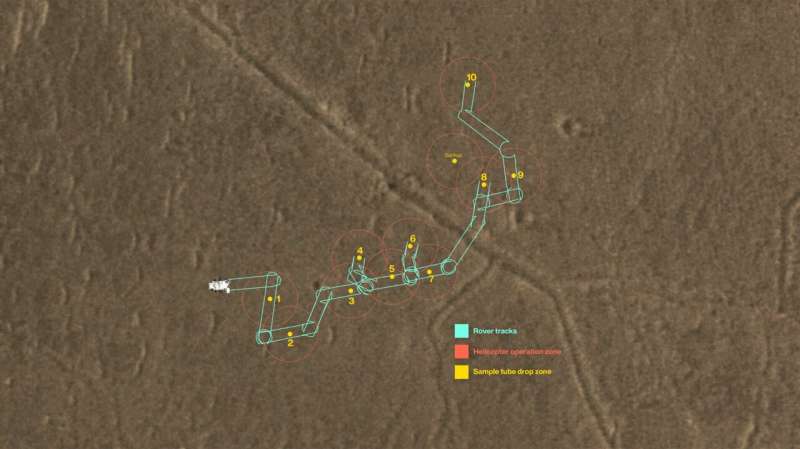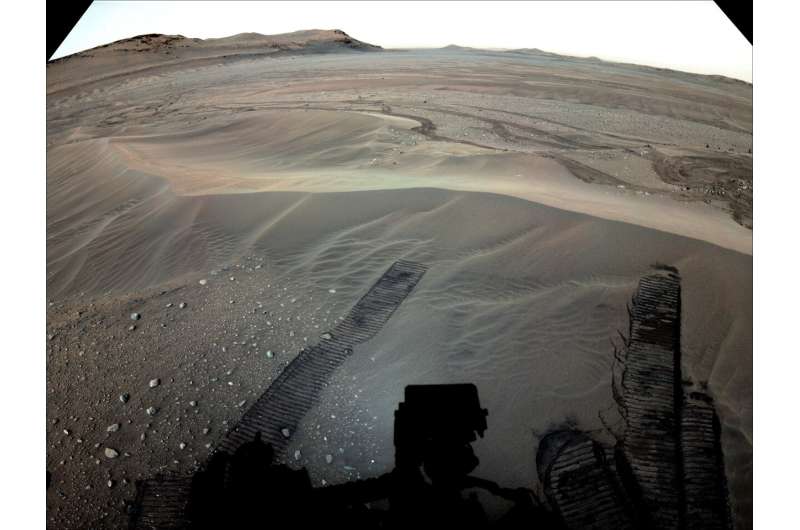" Over the course of 30 or so days, Perseverance will deposit a total of 10 tubes that carry samples representing the diversity of the rock record in Jezero Crater.
The rover has been taking a pair of samples from each of its rock targets. Half of every pair will be deposited at Three Forks as a backup set, and the other half will remain inside Perseverance, which will be the primary means to convey the collected samples to the Mars launch vehicle as part of the campaign.
"The samples for this depot—and the duplicates held aboard Perseverance—are an incredible set representative of the area explored during the prime mission," said Meenakshi Wadhwa, the Mars Sample Return program principal scientist from Arizona State University. "We not only have igneous and sedimentary rocks that record at least two and possibly four or even more distinct styles of aqueous alteration, but also regolith, atmosphere, and a witness tube."

How to build a depot
One of the first requirements to build a sample depot on Mars is to find a level, rock-free stretch of terrain in Jezero Crater where there's room for each tube to be deposited.
"Up to now, Mars missions required just one good landing zone; we need 11," said Richard Cook, Mars Sample Return program manager at NASA's Jet Propulsion Laboratory in Southern California. "The first one is for the Sample Retrieval Lander, but then we need 10 more in the vicinity for our Sample Recovery Helicopters to perform takeoffs and landings, and driving too."
After settling on a suitable site, the campaign's next task was to figure out exactly where and how to deploy the tubes within that location. "You can't simply drop them in a big pile because the recovery helicopters are designed to interact with only one tube at a time," said Cook.
The helicopters are intended to serve as a backup, just like the depot. To ensure a helicopter could retrieve samples without disturbing the rest of the depot or encountering any obstructions from the occasional rock or ripple, each tube-drop location will have an "area of operation" at least 18 feet (5.5 meters) in diameter. To that end, the tubes will be deposited on the surface in an intricate zigzag pattern, with each sample 16 to 49 feet (5 to 15 meters) apart from one another.
The depot's success will depend on accurate placement of the tubes—a process that will take over a month. Before and after Perseverance drops each tube, mission controllers will review a multitude of images from the rover. This assessment will also give the Mars Sample Return team the precise data necessary to locate the tubes in the event of the samples becoming covered by dust or sand before they are collected.
Perseverance's extended mission
Perseverance's prime mission will conclude on Jan. 6, 2023—one Mars year (about 687 Earth days) after its Feb. 18, 2021, landing.
"We will still be working the sample depot deployment when our extended mission begins on Jan. 7, so nothing changes from that perspective," said Art Thompson, Perseverance's project manager at JPL. "However, once the table is set at Three Forks, we'll head to the top of the delta. The science team wants to take a good look around up there."
Called the Delta Top Campaign, this new science phase will begin when Perseverance finishes its ascent of the delta's steep embankment and arrives at the expanse that forms the upper surface of the Jezero delta, probably sometime in February. During this approximately eight-month campaign, the science team will be on the lookout for boulders and other materials that were carried from elsewhere on Mars and deposited by the ancient river that formed this delta.
"The Delta Top Campaign is our opportunity to get a glimpse at the geological process beyond the walls of Jezero Crater," said JPL's Katie Stack Morgan, deputy project scientist for Perseverance. "Billions of years ago a raging river carried debris and boulders from miles beyond the walls of Jezero. We are going to explore these ancient river deposits and obtain samples from their long-traveled boulders and rocks."
Provided by Jet Propulsion Laboratory



